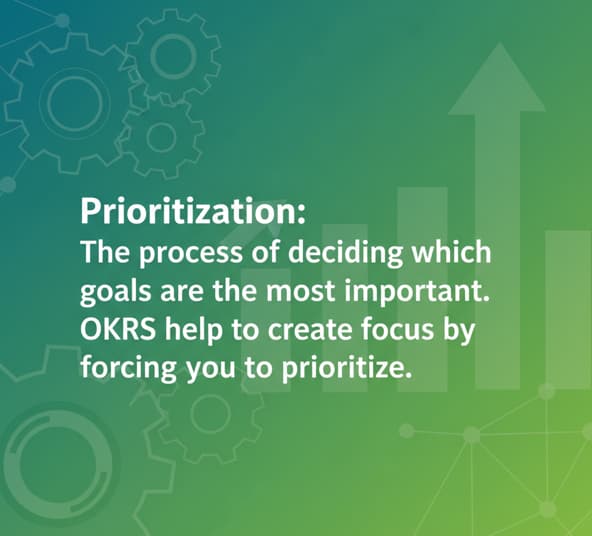The Ultimate OKR Glossary: 50+ Essential Terms to Know
The world of OKRs is filled with its own unique language. From “aspirational goals” to “cascading OKRs,” understanding the terminology is absolutely necessary to successfully implement this powerful goal-setting framework. This all-inclusive OKR glossary provides a comprehensive list of over 50 essential OKR terms that every business leader should know.
Whether you are new to OKRs or a seasoned practitioner, this glossary will serve as a valuable resource to help you navigate the world of Objectives and Key Results. Ready to dive into the ultimate OKR glossary? Let’s get started.
The A-Z of OKRs: The Ultimate OKR Glossary
In this OKR glossary, we will sort each term in alphabetical order. After we go through all 50 OKR terms, we will provide valuable advanced OKR concepts that will help you break down siloes in your team and how to integrate them into your business.

A
- Accountability: In the context of OKRs, accountability refers to the ownership of goals. Because OKRs are written and tracked, they provide a clear reference point for progress and create a culture of ownership.
- Action Item: A task that can be checked off a to-do list. Action items are not the same as Key Results, but they should be informed by your OKRs.
- Agile: A set of values and principles for software development that prioritize collaboration, adaptability, and customer-centricity. OKRs are often used in conjunction with agile methodologies.
- Alignment: The process of connecting individual and team OKRs with the company’s strategic goals. Alignment ensures that everyone is working towards the same priorities.
- Aspirational OKRs: Also known as “moonshots” or “stretch goals,” these are ambitious goals that are designed to push teams to think bigger. It is understood that a team may not achieve 100% of an aspirational OKR, but the effort to do so can lead to significant breakthroughs.
- Audacious Goal: A bold, clear, and risky goal that inspires and motivates. Aspirational OKRs are a type of audacious goal.
B
- Benchmark: A point of reference that allows you to measure progress. Benchmarks are often used as Key Results.
- BHAG (Big Hairy Audacious Goal): A term coined by Jim Collins in his book “Good to Great,” a BHAG is a long-term, ambitious goal that is designed to inspire and energize an organization.
- Bottom-up OKRs: OKRs that are created by teams or individuals in response to higher-level company OKRs. A healthy OKR implementation will have a mix of both top-down and bottom-up OKRs.
- Business As Usual (BAU): The day-to-day operations of an organization. OKRs are not meant to track BAU activities; they are meant to drive change and improvement.
C
- Cadence: The rhythm of the OKR cycle. Most organizations use a quarterly cadence, but some may use a monthly or annual cadence.
- Cascading: The process of breaking down high-level OKRs into more specific OKRs for teams and individuals. This creates alignment throughout the organization.
- CFRs (Conversations, Feedback, and Recognition): A system for continuous performance management that is often used in conjunction with OKRs. CFRs provide a way to have regular conversations about progress, provide feedback, and recognize achievements.
- Child OKR: An OKR that is nested under a parent OKR in a cascading hierarchy.
- Collective Commitment: A shared goal that everyone in the organization is committed to achieving.
- Committed OKRs: Goals that the team has committed to achieving in full. These are ambitious but realistic.
- Confidence Vote: A process where team members vote on their confidence in achieving a Key Result. This helps to identify potential roadblocks and encourages open communication.
- Continuous Performance Management: An alternative to traditional annual performance reviews that involves providing ongoing feedback and coaching throughout the year. CFRs are a key component of continuous performance management.
D
- Dashboard: A visual representation of your OKRs that allows you to track progress at a glance.
- Drill Down: The process of breaking down a high-level OKR into more specific OKRs for teams and individuals.
E
- Engagement: The level of commitment and enthusiasm that employees have for their work and the organization. OKRs can help to increase engagement by giving employees a clear sense of purpose and a direct line of sight to the company’s goals.
F
- Focus: OKRs help to create focus by limiting the number of priorities that an organization is working on at any given time.
G
- Grading: The process of scoring your Key Results at the end of an OKR cycle. Grading helps you to learn from your successes and failures and to improve your goal-setting process over time.
- Goal: A desired outcome. In the context of OKRs, the Objective is the goal.
I
- Initiative: A specific project or task that is designed to help you achieve a Key Result. Initiatives are the “how” behind your OKRs.
- Input: The resources that you put into a project or task. Inputs are not the same as Key Results, which are the outcomes that you want to achieve.
K
- Key Performance Indicator (KPI): A metric that is used to measure performance. Key Results are a type of KPI.
- Key Result: A quantitative metric that measures your progress towards an Objective.
L
- Lagging Indicator: A metric that measures past performance. Key Results are typically lagging indicators.
- Leading Indicator: A metric that can be used to predict future performance. Leading indicators are often used as initiatives.
- Learning OKRs: Goals that are focused on learning and discovery. They are used when a team is exploring a new area and needs to gather more information before setting more concrete goals.
M
- Management by Objectives (MBOs): A goal-setting framework that was developed by Peter Drucker. OKRs are an evolution of MBOs.
- Mission: The overall purpose of an organization. Your OKRs should be aligned with your mission.
- Moonshot: A highly ambitious goal that is designed to push the boundaries of what is possible. Aspirational OKRs are often referred to as moonshots.
O
- Objective: A qualitative, ambitious, and inspirational statement of what you want to achieve.
- OKR Champion: An individual who is responsible for promoting and supporting the use of OKRs within an organization.
- OKR Coach: An individual who helps teams and individuals to write and track their OKRs.
- Output: The tangible results of your work. Outputs are not the same as Key Results, which are the outcomes that you want to achieve.
P
- Parent OKR: An OKR that is at a higher level in a cascading hierarchy.
- Performance Management: The process of setting goals, tracking progress, and providing feedback to employees. OKRs are a key component of a modern performance management system.
- Prioritization: The process of deciding which goals are the most important. OKRs help to create focus by forcing you to prioritize.

R
- Reflection: The process of looking back on your OKRs at the end of a cycle to learn from your successes and failures.
- Roof shot: A goal that is challenging but achievable. Committed OKRs are often referred to as ‘roof shots.’
S
- Scoring: The process of grading your Key Results at the end of an OKR cycle.
- SMART Goals: A goal-setting framework that stands for Specific, Measurable, Achievable, Relevant, and Time-bound.
- Stretch Goal: A goal that is designed to push you beyond your current capabilities. Aspirational OKRs are a type of stretch goal.
- Strategy: A plan of action that is designed to achieve a long-term goal. Your OKRs should be aligned with your business strategy.
T
- Top-down OKRs: OKRs that are set by leadership and then cascaded down to teams and individuals.
- Transparency: The practice of making OKRs public within an organization. Transparency fosters a culture of accountability and collaboration.
V
- Vision: A long-term, aspirational statement of what you want to achieve. Your vision should guide your OKRs.
W
- Weekly Check-ins: Regular meetings held to review progress on OKRs and address any obstacles or challenges. These check-ins help maintain momentum and ensure that teams stay on track.
Y
- Year-over-Year (YoY): A comparison of performance metrics from one year to the same period in the previous year. YoY comparisons are often used in Key Results to measure growth and improvement.
Advanced OKR Concepts
As organizations mature in their OKR implementation, they often encounter more sophisticated concepts and practices. Understanding these advanced concepts can help you take your OKR program to the next level.

OKR Maturity Model
Organizations typically progress through different stages of OKR maturity:
Stage 1: Introduction Organizations are just beginning to implement OKRs. The focus is on learning the basics and establishing the fundamental processes.
Stage 2: Adoption OKRs are being used consistently across the organization, but there may still be inconsistencies in quality and alignment.
Stage 3: Integration OKRs are fully integrated into the organization’s management processes and culture. They are used to drive decision-making and resource allocation.
Stage 4: Optimization The organization continuously refines and improves its OKR processes based on data and feedback. OKRs are a natural part of how the organization operates.
OKR Anti-Patterns
Understanding common anti-patterns can help you avoid pitfalls in your OKR implementation:
Anti-Pattern 1: OKRs as Task Lists Using OKRs to track routine tasks rather than meaningful outcomes. This defeats the purpose of OKRs, which is to drive focus and ambition.
Anti-Pattern 2: Sandbagging Setting goals that are too easy to achieve in order to guarantee success. This reduces the motivational power of OKRs.
Anti-Pattern 3: Set and Forget Setting OKRs at the beginning of a cycle and then not reviewing them until the end. OKRs require regular attention and adjustment.
Anti-Pattern 4: Too Many OKRs Setting too many objectives, which dilutes focus and makes it difficult to achieve meaningful progress on any of them.
OKR Scoring and Grading
Different organizations use different approaches to scoring and grading OKRs:
Binary Scoring: Key Results are either achieved (1) or not achieved (0). This approach is simple but doesn’t capture partial progress.
Percentage Scoring: Key Results are scored based on the percentage of the target achieved. For example, if the target was to increase revenue by $1 million and the actual increase was $700,000, the score would be 70%.
Color Coding: Key Results are assigned colors based on their progress. Green typically indicates on track, yellow indicates at risk, and red indicates off track.
Confidence Levels: Teams assign confidence levels to their Key Results, indicating how likely they are to achieve them. This helps identify potential issues early.
How to Use This OKR Glossary to Build an OKR Culture at Your Business
Successfully implementing OKRs requires more than just setting goals; it requires building a culture that supports the OKR methodology:
Leadership Commitment
Leadership must be fully committed to the OKR process and model the behaviors they want to see throughout the organization
Training and Education
Ongoing training and education are essential to ensure that everyone in the organization understands how to write, track, and achieve effective OKRs.
Communication and Transparency
Regular communication about OKRs and their progress helps maintain engagement and accountability throughout the organization. Furthermore, organizations should continuously evaluate and improve their OKR processes based on feedback and results.
Build Your OKRs, Reduce Siloes, and Align Your Team
This all-inclusive OKR glossary provides a solid foundation for understanding the language and concepts of OKRs.
From basic terms like “Objective” and “Key Result” to advanced concepts like “OKR Maturity Model” and “Anti-Patterns,” this resource covers the essential vocabulary that every business leader should know.
As you continue your journey with OKRs, remember that the terminology is just the beginning. The real value comes from applying these concepts consistently and thoughtfully to drive meaningful results in your organization.
Whether you’re just starting with OKRs or looking to refine your existing implementation, understanding these terms will help you communicate more effectively and implement the framework more successfully. Want to dive even deeper? Book a course to get certified in OKRs or get in touch with an expert agile coach at Hyperdrive Agile to help you implement long-lasting and successful OKRs at your enterprise.
Questions? We Can Help.
When you’re ready to move beyond piecemeal resources and take your Agile skills or transformation efforts to the next level, get personalized support from the world’s leaders in agility.